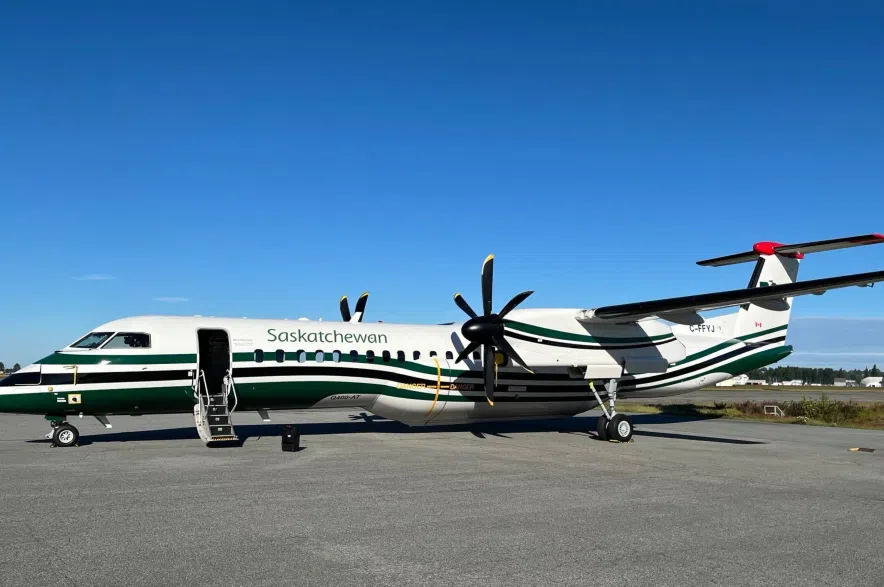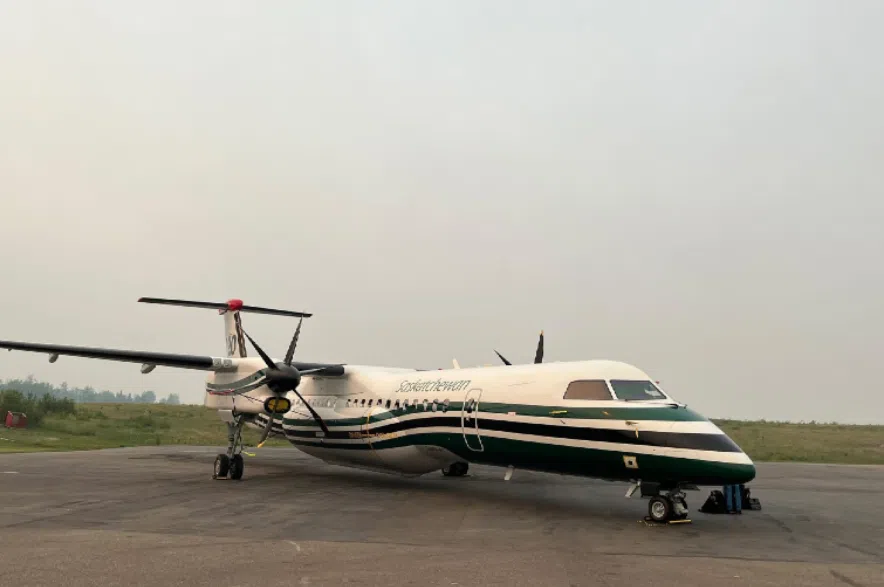A new water bomber in La Ronge sat unused while wildfires burned in surrounding communities.
The plane was delivered from Abbotsford, B.C. on May 30 and records show the aircraft, a Conair Dash 8-Q400 AT Airtanker with the tail code C-FFYJ, hasn’t logged a flight since.
Read more:
- SPSA says possibly more than 500 structures lost in Denare Beach as fire ban lifted
- Full coverage of Saskatchewan Wildfires in 2025
- Weekend rain helps firefighters battling flames in northern Saskatchewan
- Saskatchewan raises $643,156 in one day for wildfire relief
Days after its arrival, people in La Ronge, Air Ronge and the Lac La Ronge Indian Band were evacuated from their homes because of wildfires.
“Homes in Sucker River, a 15-minute drive from the (La Ronge) airport, were also lost,” Saskatchewan NDP public safety critic Nicole Sarauer said.
According to Sarauer, Premier Scott Moe lied about the plane’s location.
“We have two instances where the premier was in the public telling us that the bomber wasn’t here yet, when, in fact, the flight data shows that it clearly was,” she said.
One of those alleged instances was during a Saskatchewan Public Safety Agency (SPSA) media call on June 6.
During the call, Moe talked about the government’s significant investments to replace and upgrade Saskatchewan’s air tanker fleet, which included the purchase of four new planes.
“One of those will be arriving here this spring in the days ahead and it’ll be made available as soon as it is able,” Moe said, a week after the plane already arrived.
The other instance in question by the NDP happened during a news conference on June 11, when Moe spoke again about the one air tanker saying “We could have used (it) a few weeks ago.”
“But we’re receiving, or have received (it), in the last number of days. If not, it will be here any day now,” Moe said.
For Sarauer, these discrepancies over a plane that had arrived nearly two weeks before mean the government was either lying or had fallen “completely asleep at the wheel during a crisis.”

The plane, pictured at Abbotsford International Airport, left B.C. on May 30 which was the last flight recorded by the aircraft. (Simon Austin/Facebook)
Fighting fires is the priority, govt. says
Public Safety Minister Tim McLeod said Sarauer’s comments are an attempt by the NDP to “politicize tragedy.”
While McLeod admitted the plane arrived near the end of May, he said the four pilots chosen to fly the aircraft weren’t qualified yet.
By the time a state of emergency was declared in Saskatchewan on May 29, the pilots had received all of their simulator training.
But, McLeod said becoming fully certified under Transport Canada also requires pilots to train on the particular aircraft for 45 hours, which couldn’t be logged since the aircraft wasn’t in Saskatchewan at the time.
“The operational decision was made not to remove those four pilots from active duty fighting fires protecting our communities so that they could train on the new plane,” McLeod said.
According to SPSA vice-president Steve Roberts, getting this plane in the air sooner wasn’t just a matter of hiring more people.
“You’re flying a fast aircraft at near-stall speed in a turbulent airspace above an active fire. That is not normal. That requires very specific, trained individuals,” said Roberts.
While the agency tried to borrow qualified pilots from private vendors with no success, SPSA president Marlo Pritchard said they ended up sourcing pilots elsewhere.
“We brought in water bombers from out of province, from B.C. as well. So, we really did, I guess, enhance our capabilities and capacities,” Pritchard said, noting that the unused water bomber in La Ronge didn’t have a negative impact.
McLeod expects the four pilots will complete their training before the end of the season, finally adding the new plane into the province’s wildfire response.
Read more:











